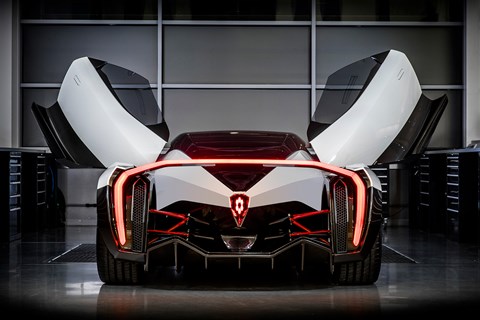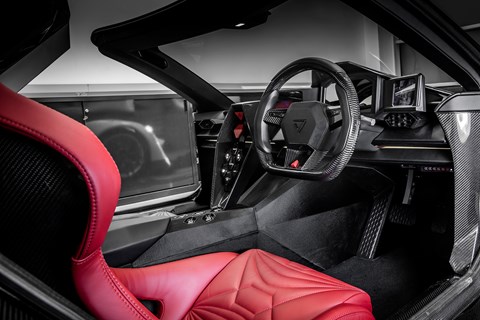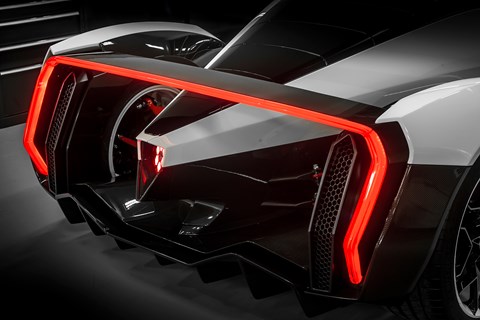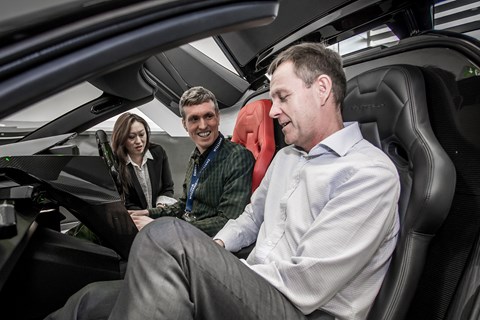► Halo project for Singapore tech firm
► Revealed at 2017 Geneva show
► Potential production run considered
Say hello to one of the most dramatic-looking and oddly named cars you’ll see in 2017: the Vanda Dendrobium, a technologically ambitious electric supercar making its official debut at the Geneva motor show.
CAR had a sneak preview of the Dendrobium before it travelled to Geneva, back in the UK at Williams Advanced Engineering, the consultancy offshoot of the F1 team tasked with engineering and building the show car on behalf of its creators, Vanda Electrics.
Here’s an up-close tour of the show car, inside and out.

Who the hell are Vanda Electrics?
A Singapore-based company specialising in battery technology and electric mobility. It’s an offshoot of parent company Wong Fong Engineering, a big player in big objects – cranes, tailgates and military equipment, for example.
Still in its nascent stages, Vanda Electric operates under separate management, and became incorporated early in 2016.
It hasn’t built a car before, nor does it plan to become a volume automotive manufacturer. The closest thing to a series production vehicle in its current portfolio is the rather beguiling little Motochimp electric scooter, which goes on sale in Japan in summer 2017, and the Ant Truck, a square-cut one-tonne EV load-lugger heading for production before 2018.
The Dendrobium is intended as a halo project, to build interest and awareness in the brand. A second car may follow, should the Dendrobium be successful.

Will the Dendrobium go into production?
‘We are still deciding whether to put the car into production fully,’ Vanda Electric CEO Larissa Tan told CAR. ‘The plan is to do so, but reaction at Geneva will be key. If it does, it will be made in the tens rather than the hundreds.’
Should the Dendrobium make the jump into production, Williams Advanced Engineering will again most likely be the construction partner.
At the time of writing, Vanda hasn’t yet named a potential price for the production car, nor taken deposits, with final decisions to be taken post-Geneva. Nonetheless, we’re told we can expect a production version to carry ‘a seven-figure price tag.’

Dendrobium? What’s with the name?
It’s a species of orchid native to Singapore. Much of the concept’s design is inspired by nature, with honeycomb patterns a recurring theme. The rear-hinged roof and doors in particular are intended to echo the petals of an orchid, and look suitably dramatic as they unfold.
Roof and doors can be opened independently of each other via the key fob. Engineering the rearward-hinged set-up to withstand the slings and arrows of aerodynamic forces at high speeds is an extra challenge, but if anyone can do it, Williams can.
‘[We chose] Williams as a partner because they’re good at this: structures, aerodynamics, electrification, low-volume build,’ Tan says.

Looks fast. Is it?
The numbers associated with the Dendrobium’s projected performance are startling: 0-62mph in as little as 2.6sec, and a top speed of around 200mph.
Ian Cluett, head of programmes at Williams Advanced Engineering, told CAR his team are targeting a kerb weight of 1750kg. ‘It’s hard to make a two-tonne-plus car fast,’ he says. ‘Weight is the key for this car – there’s still lots to come.’
Power, range, and the powertrain configuration itself for that matter, are still to be finalised. It may feature four in-board electric motors, or three; regardless, it will power all four wheels. Currently the car is designed to use a single-speed gearbox at the front and multiple gears at the rear, with conventional differentials rather than a more complex motor vectoring system.
Likewise, which type of motors will be used is still TBC, but Cluett tells us the Dendrobium won’t use the same motors as the Williams-developed Formula E powertrain. Total power output is likely to exceed the equivalent of 1000bhp.
If the Dendrobium does go on sale, when will it reach the road?
Two years after the decision, Larissa Tan tells us – by which time battery technology will naturally have moved on again. Tan says the production car’s powertrain ‘will fit a hypercar at that time,’ in terms of its performance and technological advancement.
The car’s essential design has existed as a concept project since the mid 1990s, Tan explains, and was always intended to be an EV. Although the project was revisited again in the mid 2000s. ‘We were waiting for technology to catch up with the design, for the time to be right. We decided now that the time is right to realise it.’

Vanda Dendrobium: the design story
Williams received the initial sketches from Vanda in December 2015, and started work early the following year.
The tapering tail design was a particular challenge, Williams’ engineers explain. That distinctive wrap-over rear spoiler with its integrated light graphic was a key part of the design from the outset, and the standalone rear fenders with exposed rear suspension. The wing assembly is actually supported by the lower diffuser surface, but you can’t tell – Williams has done a neat job of translating the design to the show car.
Project insiders acknowledge that the concept’s multi-surface, open-fendered design doesn’t lend itself to weight-saving, or allow as much space for the batteries as a single-volume shape would, but it’s a commendably distinctive design.
The chassis is a carbon monocoque, with the battery behind the seats on the other side of a protective bulkhead; occupant protection and battery protection is part and parcel of the challenge of designing BEVs (Battery Electric Vehicles).

What’s it like inside?
The sills are usefully low, and the lifting roof panel helps ingress too, although even with it in place climbing in and out is no more or less difficult than most supercars.
There’s clearly still some work to do on the driving position; the H-point is higher than you might expect, and the seats (designed with a stitching pattern intended to echo muscle fibres) feel quite upright. I’m average height and found my head very close to the ceiling, but shoulder room is reasonable for two average-sized adults.
The digital instrument panel cycles through a pre-programmed display, and ancillary screens display a remarkably clear rear view from side-mounted cameras in lieu of mirrors – production of which are subject to individual market regs.
There’s no fashionable touchscreen, with conventional switchgear mounted within a honeycomb-themed centre console. Nor is there a rear window, with a carbon bulkhead panel from roof to floor and the cameras taking care of rearward vision.
Just how working is this working prototype?
More thoroughly finished than many concept cars; it drives, albeit not at road car pace, but steers properly. All the hard points are set; packaging, suspension geometry, kinematics, steering rack and so on. As mentioned before, however, there’s plenty more to be finalised for the production version – the next few days at Geneva will do much to determine the Dendrobium’s future.
Would you choose a Dendrobium over a conventional, established supercar? Maybe not, but you get the feeling that potential Vanda customers might be tech fans rather than traditional car enthusiasts. An intricate, different design that’s set Williams some challenges, it’s one of the more enjoyably curious machines at Geneva 2017. Let’s see what happens next.
Click here for CAR’s guide to all the new cars at Geneva 2017